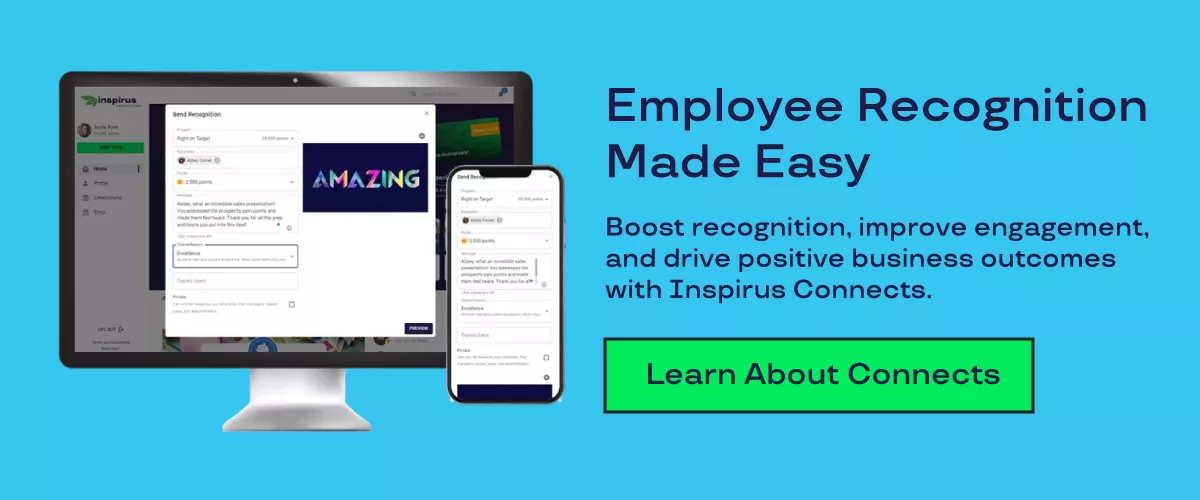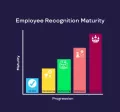
Maximizing Employee Performance With the Right Incentives and Rewards
May 2, 2024
Make your team feel more valued and motivated to strive for excellence with robust employee incentives and rewards.
Here’s the situation in almost every workplace: employers want productive, highly motivated teams and employees want to be recognized for their efforts. Fortunately, there is an employee engagement strategy that fulfills both parties’ needs: a recognition program with the right incentives and rewards.
The research into the power of employee recognition is clear. Acknowledging and rewarding contributions helps with everything from employee motivation to job satisfaction to retention rates.
According to Harvard Business Review, for instance, 40 percent of U.S. employees say they would put more effort into their work if they were recognized more frequently. Likewise, a Deloitte Insights survey found that companies that make employee recognition a priority are 12 times more likely to achieve positive business outcomes.
So, how do you tap into the power of recognition in a tangible and meaningful way? With employee incentives, including non-monetary rewards, that make everyone on the team feel valued and motivated.
Rewards and Incentives Demystified
A thoughtful understanding of what truly motivates employees lies at the heart of any successful incentive and rewards program. Done right, they act as catalysts inspiring each team member to achieve and exceed goals.
But first, what’s the difference between an incentive and a reward in the workplace?
→ Incentives are proactive measures designed to encourage desired behaviors or actions among employees. They are announced in advance and help provide something to work towards.
→ Rewards are retrospective and given after the fact in recognition of achievements or contributions.
While employee incentive programs and tangible rewards aren’t a requirement in any workplace, the truth is that employees’ expectations from their jobs have shifted in recent years. Standard benefits and compensation alone aren’t enough to foster loyalty. Other factors like company culture, a supportive manager and genuine recognition are irreplaceable.
On top of that, traditional employee engagement rewards like a pizza party or company-branded swag no longer hit the mark, and can often have a negative effect on retention and culture. So, what do employees want? Monetary rewards like spot bonuses or gift cards are always well received. Travel, experiences and additional time off also top the list of best rewards, according to a recent report by the Incentive Research Foundation.
Expanding your rewards and going the extra mile can make all the difference in terms of employee engagement, satisfaction, productivity and retention.
6 Tips on How to Effectively Utilize Incentives To Improve Employee Performance
#1 Align Incentives with Goals
Of course, your rewards program doesn’t exist in a vacuum – it serves a specific purpose. Incentives and rewards are most effective when they are directly tied to your organization’s goals and objectives.
This might include overarching company goals like:
- Increasing sales
- Improving customer satisfaction
- Innovating
- Enhancing product or service quality
Aligning rewards with clearly communicated goals can help channel employees’ efforts and energy towards those desired outcomes. That could look like offering a spot bonus for five-star reviews, prizes in an innovation competition or commissions on sales, for example.
#2 Offer Varied Incentives To Motivate Employees
Different employees are motivated by different incentives.
As just one example of how this plays out along generational preferences, the Incentive Research Foundation found:
- Younger workers (18-30) like merchandise and experiences better than their mid-career and late-career stage counterparts do.
- Early and mid-career workers prefer travel rewards to destinations that include a flight, while late-career workers prefer drivable domestic destinations – although a trip to Hawaii topped the list for all age groups.
- Late-career workers showed a slight preference for “big show” recognition like an awards ceremony or company.
- Workers of all ages list gift cards and cash as their favorite reward types.
The point is, that offering a variety of incentives can help ensure that all employees feel valued and appreciated in the ways they prefer. That’s why using a points-based reward program like Inspirus – where points can be redeemed for a range of gifts, travel, experiences, charitable giving and more – can make rewarding employees easy.
#3 Be Timely in Recognition
Timely recognition holds immense power in boosting employee morale and driving sustained performance. When employees receive prompt acknowledgment for their accomplishments, it validates their efforts and instills a sense of pride and satisfaction. Conversely, delaying recognition can diminish the impact of the incentive program and dampen motivation levels.
Consider a scenario where an employee goes above and beyond to meet a tight deadline or exceeds sales targets for the quarter. If their achievement is promptly recognized, it reinforces the connection between their efforts and the organization's appreciation, motivating them to maintain high-performance levels.
On the other hand, if recognition is delayed or overlooked entirely, it sends the message that their contributions are not valued, potentially leading to disillusionment and disengagement.
Even small gestures of recognition – such as a personalized email, a public shout-out during a team meeting or a handwritten note from a manager – can have a profound impact when delivered in a timely manner. Not only does this make the employee feel valued, but it also helps create a company-wide culture of appreciation.
#4 Make Incentives Achievable
Setting realistic and achievable targets is crucial for the success of any incentive program. Unattainable goals can demotivate employees, leading to frustration and disengagement.
Instead, strive to set targets that are challenging yet attainable. This helps encourage employees to stretch themselves while still feeling a sense of accomplishment.
Of course, feel free to adjust the level of reward based on the accomplishment – not all achievements need to be met with an international trip or triple-digit bonus. But don’t only wait for career-making moments to show acknowledgment.
Frequent smaller shows of appreciation for day-to-day achievements are just as important as one-off big gestures, if not more so.
#5 Promote Transparency in Incentive Programs
Transparency is key to building trust and fostering a positive work environment. When it comes to incentive programs, it's essential to be transparent about the criteria for earning incentives and the process for evaluating performance.
- Clearly communicate the criteria for earning incentives.
- Foster open communication channels where employees can ask questions, seek clarification and provide feedback on the incentive program.
- Keep employees informed about the progress of the incentive program and any updates.
- Treat all employees equally and apply the same criteria and standards to everyone eligible for incentives.
- Provide resources and policies about the program accessible to all employees.
- Actively seek feedback from employees about their experiences with the incentive program and any suggestions for improvement.
- Address any concerns or questions raised by employees about the incentive program promptly and transparently.
#6 Encourage Team Collaboration and Create Healthy Competition
Team-based incentives can be an effective way to promote collaboration and teamwork within the organization, while still creating healthy competition to motivate employees.
Recognize and reward team achievements and successes to reinforce the importance of collaboration and teamwork. Celebrate milestones, accomplishments and breakthroughs as a team, and publicly acknowledge the contributions of individual team members. Recognition serves as positive reinforcement and motivates teams to continue working together towards common goals.
At the same time, don’t overlook the importance of leading by example. Managers and others in leadership positions play pivotal roles in promoting team collaboration by modeling collaborative behaviors and fostering a supportive, inclusive work environment. Leaders should demonstrate humility, active listening and a willingness to collaborate with others, setting the tone for collaborative teamwork throughout the organization.
3 Examples of Successful Companies That Incentivize Their Employees
Let's take a closer look at some examples of great rewards and incentive programs in action from a few top companies renowned for their high levels of employee engagement.
Google is well known for its innovative and employee-friendly workplace culture, which is characterized by a wide range of perks and rewards. Employees at Google enjoy generous salaries, stock options and a host of on-site amenities – including free meals and snacks, fitness centers and wellness programs.
Plus, Google emphasizes career development with opportunities for employees to pursue their passions and interests. Initiatives like "20% Time" encourage employees to dedicate a portion of their workweek – 20 percent of their time, as the name alludes – to side projects that are more innovative and creative than day-to-day to-do lists.
Zappos
The company's rewards program, aptly named "Zapponians," offers employees a plethora of perks and benefits, including free lunches, on-site wellness activities, employee discounts on merchandise and opportunities for professional development.
Zappos is known for fostering a fun and creative work environment, with regular team-building events, celebrations and initiatives that create a culture of trust and autonomy that empowers employees.
Salesforce
Salesforce is regularly ranked as one of the "Best Places to Work” thanks to its strong focus on employee well-being and engagement. The company offers a comprehensive rewards program that includes competitive salaries, performance-based bonuses and equity awards.
In addition to monetary incentives, Salesforce embraces a cultural philosophy of “Ohana” – a Hawaiian term meaning family – which permeates all its programs, including incentives and rewards. This helps create a work environment where employees feel valued, respected, and empowered to thrive.
Make Employees Feel Valued
Investing in employee well-being with a thoughtful, authentic reward system is not only beneficial for individuals but also for the overall success of the organization. When employees feel appreciated and respected, they are happier, more productive and less likely to leave for another position elsewhere.
By offering personalized recognition experiences, meaningful rewards and opportunities for growth and development, tapping into the power of incentives to maximize employee performance is easy.





